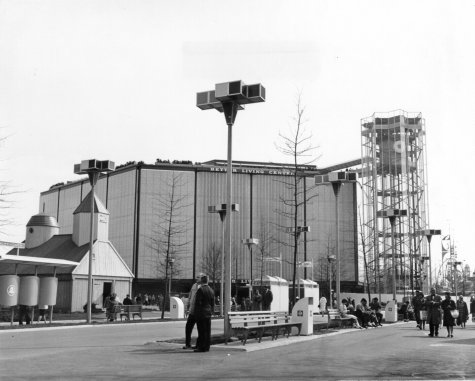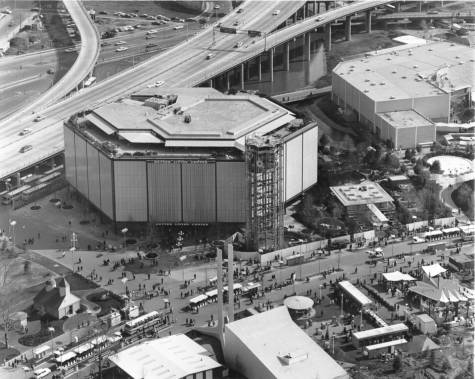|
An historic Civil War locomotive!
... The world's largest model train exhibit! ... Daily shows
featuring the latest fashions from America's leading designers!
... A dream house display of home furnishings! ... Exotic animals
living naturally among home furnishings! ... A flowing water
faucet seemingly suspended in mid-air! ... Priceless works of
American art! ... Tasty samples of chocolate and cookies! ...
A musical revue puppet show featuring one of the most famous
commercial symbols of American industry!
Does that sound like the
kind of diversity that best epitomizes the things to be found
in the vast 600 acres and 150 plus pavilions of the 1964-1965
New York World's Fair? Actually, all of this could be found in
one building alone: The Better Living Center, situated in the
Industrial Area and flanked on either side by two of Walt Disney's
major attractions, the General Electric and Pepsi Cola pavilions.
This four story structure was both the tallest and largest in
the entire Industrial Area and was meant to provide, not just
a diversity of exhibits, but an outlet for exhibitors who wanted
to be involved with the Fair yet were unable or unwilling to
spend the money necessary to build their own pavilion. In addition,
those exhibitors who might have at first glance been more at
home in a more specialized building like the Pavilion of American
Interiors or the (never-constructed) World Of Food conceivably
saw the Better Living Center, with it's "potpourri"
approach of a variety of exhibits dedicated to the theme of better
living, as an ideal place to call attention to themselves in
a smaller setting.
-
Ground
Level view of the Better Living Center
SOURCE: New
York World's Fair Publicity Photograph presented courtesy Craig
Bavaro collection
|

|
The 1964-1965 New York
World's Fair's own "potpourri" approach of soliciting
sponsors for multi-exhibitor pavilions, whether done consciously
or not, hearkened back to the first significant World's Fair
in London in 1851. For that Fair all of the industrial exhibits,
scientific demonstrations and international displays were housed
inside one facility, the massive glass and iron "Crystal
Palace. " The success of the "Great Exhibition"
of 1851 insured that the legacy of the Crystal Palace would never
be forgotten. The Better Living Center, World of Food, Pavilion
of American Interiors, Hall of Education and the Transportation
& Travel Pavilion were all privately sponsored, multi-exhibitor
buildings and among the largest structures at the at the 1964-1965
Fair. By their nature they were the Fair's own Crystal Palaces
-- yet not constructed or financially supported by the Fair itself.
Interestingly, a history-minded organizer of the Better Living
Center was no doubt thinking back to 1851 when it was decided
that one of the major exhibits planned for the building, a daily
fashion show, would be called "The Crystal Palace of Fashion."
Promotional advertising
for the Better Living Center suggested that it might be a pavilion
geared more toward women. That certainly seemed true with such
planned exhibits as The Crystal Palace of Fashion and the presence
of a "Women's Hospitality Center." But there were plenty
of other exhibits that cut across gender lines, as well as others
that were aimed at children. With an observation deck offering
one of the best views of the entire Fair next to that of the
New York State Pavilion's observation towers, and a rooftop
restaurant, the Better Living Center should surely have been
able to draw in large crowds of Fairgoers of all ages. Such
was not to be the case. While the Better Living Center ultimately
didn't do as poorly to the degree that true disasters like the
Pavilion of American Interiors or the Hall Of Education did,
it was one of the Fair's more conspicuous failures. Even its
prime location next to some of the Fair's biggest successes did
not help it.
The Better Living Center
had to overcome a rocky beginning. It failed to open smoothly
in April, 1964 with the rest of the Fair. A number of top exhibits,
especially those on the third floor, were not ready on Opening
Day and weren't fully in place for as much as a full month after.
As Better Living Center President Richard Burge explained in
a May 26, 1964 letter to Fair officials discussing the state
of the pavilion, "There are very great problems inherent
in effectively coordinating and installing in excess of 125 exhibitors
in a building of the nature and size of ours." Construction
delays in getting new exhibit space finished after the Fair opened
grew so bad that the pavilion operated during its first month
without a formal Operating permit (third floor exhibitor Canada
Dry regarded the building conditions as "deplorable").
This led the Fair's Director of Safety, W.J. Hyland, to make
a subtle threat that unless problems were immediately dealt with
he might have the pavilion closed. Burge then employed work crews
around-the-clock to make sure Hyland's objections were addressed.
The major problem with
the Better Living Center was that it forced Fairgoers to take
only one proscribed route through the pavilion to visit the exhibits.
All visitors were required to start their tour from the
top floor by taking the Lifesavers-sponsored glass elevator to
the rooftop restaurant or an escalator that went from the Lobby
to the first floor mezzanine, then a second escalator leading
to the third floor exhibit area where they would begin to wind
their way down through every exhibit in the building.
The New York World-Telegram, in what was for the most
part a favorable profile of the pavilion, likened the whole design
to that of a mousetrap aimed at trapping Fairgoers into seeing
every part of the building (and forcing them to follow yellow-painted
footprints on the floor as they made their way down). For someone
who was only interested in seeing one or two specific things
in the pavilion, there might have been a disinclination to enter
the building and allow oneself to be "trapped" for
however long it might take to make one's way back down -- having
to enjoy (or endure) every exhibit along the way. By designing
the building this way the pavilion's sponsor, Edward H. Burdick
Associates., Inc., could assure exhibitors that they would get
their money's worth out of exhibiting in the Better Living Center.
Once inside, the Fairgoer had no choice but to
see their exhibit. It was a classic example of an "idea
that looked good on paper." Ultimately, this concept kept
more people away than it enticed to venture in.
Despite its ultimate failure
the Better Living Center's mere existence, and a closer look
at some of what it had to offer, can provide a genuine insight
into the nature of what Robert Moses called "Something for
Everyone" and the vast scope of what the 1964-1965 New York
World's Fair was all about.
So ... taking the proscribed
route of top floor down, let's visit the Better Living
Center!
-
Aerial
view of the Better Living Center
-
(View a Larger Version of this Photograph)
SOURCE: New
York World's Fair Publicity Photograph presented courtesy Craig
Bavaro collection
 |
* * *
|